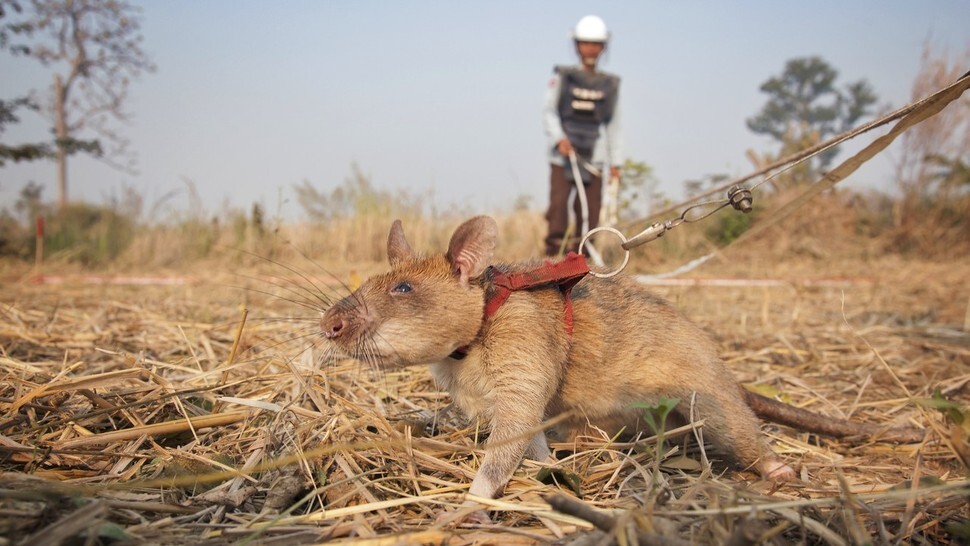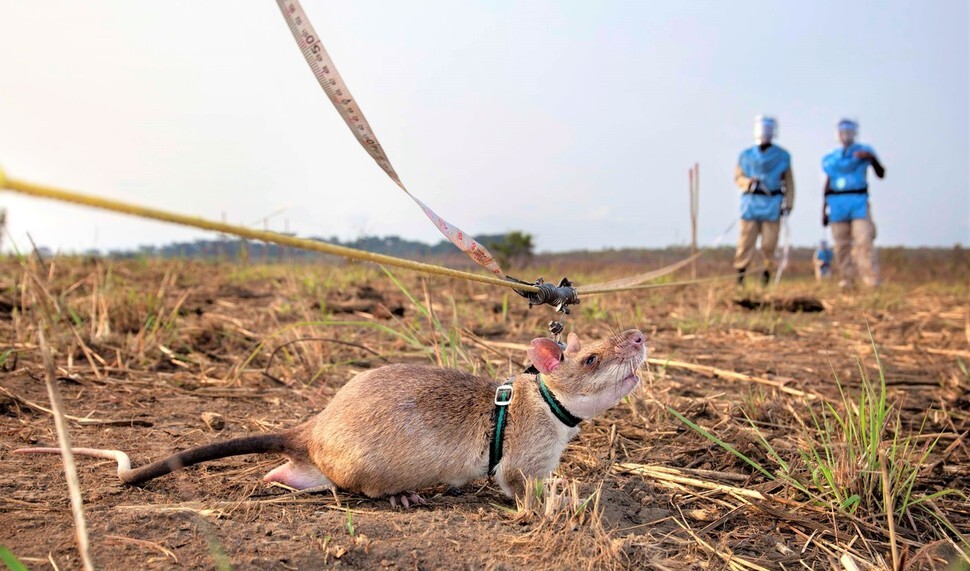hankyoreh
Links to other country sites 다른 나라 사이트 링크
Nonprofit suggests using pouched rats to detect landmines in DMZ

A nonprofit organization has proposed using pouched rats to find the more than 2 million landmines that are estimated to be buried on the Korean Peninsula.
On Mar. 20, APOPO, a Belgian-based private-sector research organization, proposed that the South Korean central and local governments train and use African giant pouched rats to detect buried landmines. The pouched rats, APOPO says, are 20 times more efficient than humans and could reduce the current cost by 80%. While it would take more than 200 years for humans with metal detectors to clear all the mines in the country, pouched rats could complete the job within 15 years, the nonprofit said.
One of the behaviors of the African giant pouched rat, also called the Gambian pouched rat, is that it buries food in the ground and then returns to locate it by its scent. APOPO has taken advantage of this characteristic to train the pouched rats to locate buried landmines by their smell and uses them in its landmine detection work. When trained pouched rats smell gunpowder, they wait on the spot and keep squeaking until humans show up. Since the rats don’t exceed 1.5kg in weight even when full-grown, they’re in no danger of setting off the landmines.
African giant pouched rats have an average lifespan of eight years. After being trained at a center in Tanzania for nine months, the pouched rats are put into action and then retired after five or six years on the job.
Pouched rats are currently being used to clear landmines in nine countries: Mozambique, Tanzania, Cambodia, Angola, Zimbabwe, Colombia, Vietnam, Laos and Thailand. Through this method, 200,000 mines were cleared from an area of 21 million square meters in Mozambique and 45,000 mines from an area of 15 million square meters in Cambodia.
Pouched rats have yet to be used in landmine removal in Korea. But the city of Yangsan in South Gyeongsang Province, which has to deal with the headache of landmines left around old US military bases, is showing interest in the idea. “On several occasions, we’ve asked the Ministry of National Defense to clear all the landmines on Mt. Cheonseong. APOPO got in touch with the idea of clearing landmines with African giant pouched rats, and we asked them to talk to the Ministry about it,” a city official said.

Program to clear mines around fortress in Cherwon County in DMZ
APOPO has proposed a trial program in which pouched rats would clear mines laid around an ancient fortress built by Gung Ye (869-918) in Cheorwon County, Gangwon Province. Heavy equipment can’t be brought into the area, which is a historical site in the demilitarized zone (DMZ), and the high iron content in the soil makes it difficult to find landmines with metal detectors. APOPO has suggested bringing in 10 pouched rats to do work on a probationary basis.
“We haven’t received an official proposal from APOPO yet. If the proposal is made to the unit in question, it will report that proposal to the Joint Chiefs of Staff, which will then deliberate the matter with us,” said an official from the Ministry of National Defense.
Currently, only the South Korean military has the authority to clear mines. Before private-sector technology can be brought to bear, there will reportedly have to be a full review of related laws.
During the division of the Korean Peninsula and the Korean War, some 2 million mines were reportedly laid in the DMZ, while about 10,000 more mines were laid in more than 60 sites behind the front lines. A substantial number of these mines are presumed to have shifted from their original location because of rainfall and flooding in the intervening years.
By Choi Sang-won, South Gyeongsang correspondent, and Yoo Kang-moon, senior staff writer
Please direct comments or questions to [english@hani.co.kr]

Editorial・opinion
![[Editorial] Does Yoon think the Korean public is wrong? [Editorial] Does Yoon think the Korean public is wrong?](https://flexible.img.hani.co.kr/flexible/normal/500/300/imgdb/original/2024/0417/8517133419684774.jpg) [Editorial] Does Yoon think the Korean public is wrong?
[Editorial] Does Yoon think the Korean public is wrong?![[Editorial] As it bolsters its alliance with US, Japan must be accountable for past [Editorial] As it bolsters its alliance with US, Japan must be accountable for past](https://flexible.img.hani.co.kr/flexible/normal/500/300/imgdb/original/2024/0417/6817133413968321.jpg) [Editorial] As it bolsters its alliance with US, Japan must be accountable for past
[Editorial] As it bolsters its alliance with US, Japan must be accountable for past- [Guest essay] Amending the Constitution is Yoon’s key to leaving office in public’s good graces
- [Editorial] 10 years on, lessons of Sewol tragedy must never be forgotten
- [Column] A death blow to Korea’s prosecutor politics
- [Correspondent’s column] The US and the end of Japanese pacifism
- [Guest essay] How Korea turned its trainee doctors into monsters
- [Guest essay] As someone who helped forge Seoul-Moscow ties, their status today troubles me
- [Editorial] Koreans sent a loud and clear message to Yoon
- [Column] In Korea’s midterm elections, it’s time for accountability
Most viewed articles
- 1[Column] The clock is ticking for Korea’s first lady
- 2Samsung barricades office as unionized workers strike for better conditions
- 3[Editorial] When the choice is kids or career, Korea will never overcome birth rate woes
- 4[News analysis] After elections, prosecutorial reform will likely make legislative agenda
- 5S. Korea, Japan reaffirm commitment to strengthening trilateral ties with US
- 6Why Israel isn’t hitting Iran with immediate retaliation
- 7[Guest essay] How Korea turned its trainee doctors into monsters
- 8Japan officially says compensation of Korean forced laborers isn’t its responsibility
- 9[Editorial] Does Yoon think the Korean public is wrong?
- 10[Editorial] 10 years on, lessons of Sewol tragedy must never be forgotten